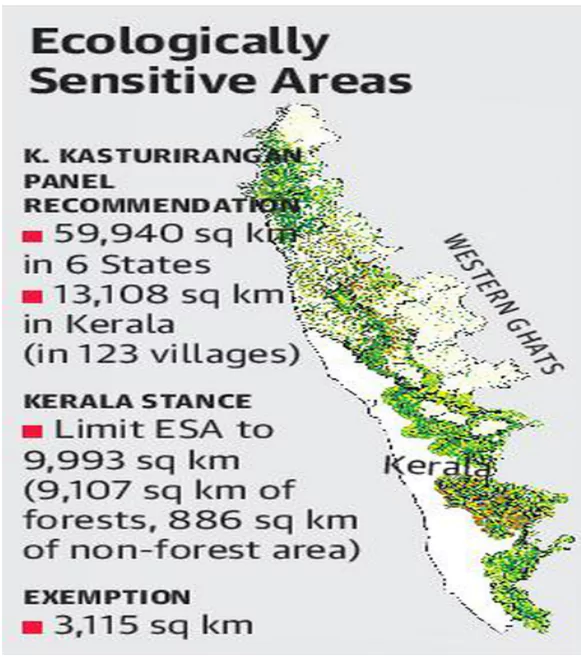The Karnataka government has asked the Union Ministry of Environment, Forest and Climate Change (MoEF&CC) to withdraw the sixth draft notification issued by it for declaration of Eco-Sensitive Area (ESAs) of the Western Ghats.
Background
- On July 31, 2024, MoEF&CC reissued the draft notification for the sixth time in a decade, proposing to classify parts of the Western Ghats in six states as ESAs.
- Objections and suggestions were called for within a 60-day period.
- Karnataka rejected the Kasturirangan Committee report in a Cabinet meeting on September 26.
- The government argues that implementing the report would cause hardships to 1,499 villages across 33 taluks in 10 districts of Karnataka, affecting lakhs of residents.
Enroll now for UPSC Online Course
About Ecologically Sensitive Areas (ESAs)

- Eco-Sensitive Areas (ESAs)are located within 10 kms around Protected Areas, National Parks and Wildlife Sanctuaries.
- It acts as a transition zone for areas which have less protection to areas which have high protection.
- These are notified by the Ministry of Environment, Forest and Climate Change (MoEFCC) under Environment Protection Act 1986.
- Established since 2002, ESZs act as buffer zones, providing an additional layer of wildlife protection by serving as “shock absorbers,” facilitating a smooth transition from strictly protected zones to areas with more relaxed conservation regulations.
- It is also known as Ecologically Fragile Areas (EFAs).
Conservation Efforts for Western Ghats
- Government has taken various measures to conserve biodiversity with the establishment of Protected Area network, tiger reserves and biosphere reserves.
- Nearly 10% of the total area of Western Ghats is currently covered under protected areas.
- The government has also taken initiative to demarcate Ecologically Sensitive Areas (ESA) for promotion of environment-friendly and socially inclusive development.
Madhav Gadgil Committee (2011)
- Classification of Ecologically Sensitive Zones (ESZs): The report proposed classifying 64 percent of the Western Ghats, spread over six states, into three categories – ESZ 1, ESZ 2, and ESZ 3.
- Ecologically Sensitive Area (ESA): The entire Western Ghats region was recommended to be designated as an Ecologically Sensitive Area.
- Developmental Activities: The report called for a halt to almost all developmental activities like mining, construction of thermal power plants, and dams in ESZ 1.
- Bans and Restrictions: Genetically modified crops, plastic bags, Special Economic Zones, new hill stations, and changes in land use from farmland to non-farm land were to be prohibited.
- The diversion of rivers to protect the ecology of the region and conversion of public lands into private lands were also discouraged.
- Bottom-to-Top Governance: The report suggested a decentralised approach to governance with more power given to local authorities.
- It recommended the establishment of a Western Ghats Ecology Authority under the Environment (Protection) Act, 1986, to manage the region’s ecology and ensure sustainable development.
- Ban on Single Commercial Crops: The report called for a ban on growing single commercial crops like tea, coffee, cardamom, rubber, banana, and pineapple in the Western Ghats, as they had negative environmental impacts.
Check Out UPSC NCERT Textbooks From PW Store
Dr. K Kasturirangan Committee (2013)
- Reduced Ecologically Sensitive Area: It has designated only 37% of the Western Ghats as ecologically sensitive.
- Categorization of Regions: The panel split the Western Ghats into two categories – cultural regions (human settlements) and natural regions (non-human settlements).
- It proposed designating cultural lands as an Ecologically Sensitive Area.
- Categorization of Activities: The report introduced a classification of activities into three categories – red, orange, and green.
- Red Category: Activities, such as mining, stone quarrying, were recommended to be banned.
- Orange Category: Activities would be regulated and allowed with appropriate permissions.
- Green Category: All agricultural, horticultural, and certain commercial activities were allowed.
About Western Ghats
- Older than the Himalaya mountains, the mountain chain of the Western Ghats represents geomorphic features of immense importance with unique biophysical and ecological processes.
- Location: Stretches 1,600 km (990 mi) along the western coast of the Indian peninsula.
- Coverage: 160,000 km² (62,000 sq mi) across six states: Gujarat, Maharashtra, Goa, Karnataka, Kerala, and Tamil Nadu.
- Local Names:
- Sahyadri: In Maharashtra
- Nilgiri Hills: In Karnataka and Tamil Nadu
- Anaimalai Hills and Cardamom Hills: In Kerala
- Formation and Geology:
- Formation: Created during the break-up of the supercontinent Gondwana in the late Jurassic and early Cretaceous periods.
- Geological Evidence: The mountains were formed when India separated from Africa and rose along the west coast.
- Composition: The Deccan Plateau is made of basalt rocks, influencing the rise of the Western Ghats.
- Topographical Variation: Higher in elevation (average elevation about 1,500 m) and more continuous compared to the Eastern Ghats, with height increasing from north to south.
- Protected Areas in the Western Ghats: Protected Areas Includes two biosphere reserves, 13 National Parks, several wildlife sanctuaries, and many Reserve Forests.
- Major Protected Areas include Nilgiri Biosphere Reserve and Silent Valley National Park
- Recognition: Western Ghats was declared as a world heritage site in 2012 by the United Nations Education, Scientific and Cultural Organisation (UNESCO).
- It is one of the eight ‘hottest hotspots’ of biological diversity in the world.
Enroll now for UPSC Online Classes
![]() 1 Oct 2024
1 Oct 2024

